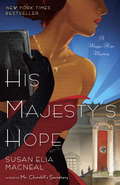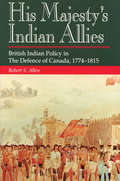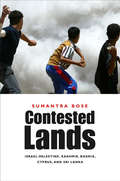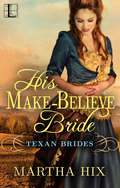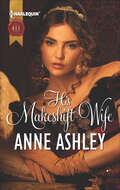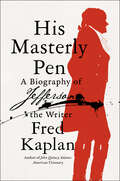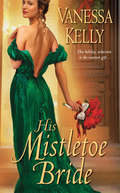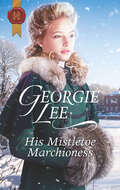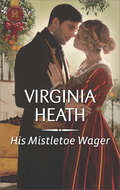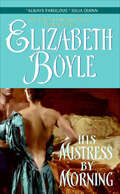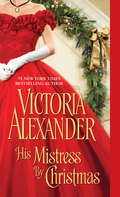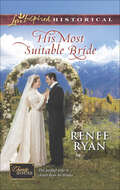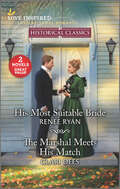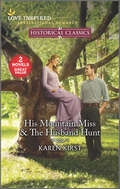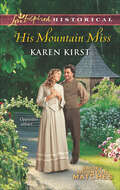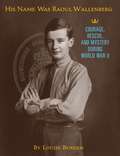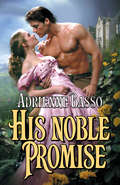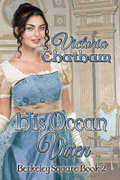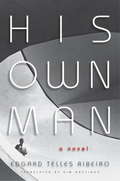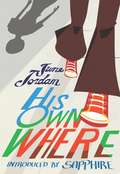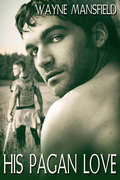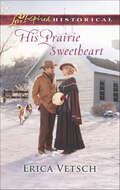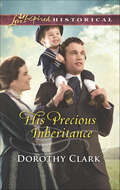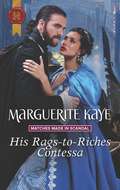- Table View
- List View
His Majesty's Hope
by Susan Elia MacnealNEW YORK TIMES BESTSELLERFor fans of Jacqueline Winspear, Laurie R. King, and Anne Perry, whip-smart heroine Maggie Hope returns to embark on a clandestine mission behind enemy lines where no one can be trusted, and even the smallest indiscretion can be deadly.World War II has finally come home to Britain, but it takes more than nightly air raids to rattle intrepid spy and expert code breaker Maggie Hope. After serving as a secret agent to protect Princess Elizabeth at Windsor Castle, Maggie is now an elite member of the Special Operations Executive--a black ops organization designed to aid the British effort abroad--and her first assignment sends her straight into Nazi-controlled Berlin, the very heart of the German war machine. Relying on her quick wit and keen instincts, Maggie infiltrates the highest level of Berlin society, gathering information to pass on to London headquarters. But the secrets she unveils will expose a darker, more dangerous side of the war--and of her own past."You'll be [Maggie Hope's] loyal subject, ready to follow her wherever she goes."--O: The Oprah MagazineFrom the Trade Paperback edition.
His Majesty's Indian Allies: British Indian Policy in the Defence of Canada 1774-1815
by Robert S. AllenHis Majesty’s Indian Allies is a study of British-Indian policy in North America from the time of the American Revolution to the end of the War of 1812, with particular focus on Canada.
His Majesty’s Opponent: Subhas Chandra Bose and India's Struggle against Empire
by Sugata BoseThe man whom Indian nationalists perceived as the “George Washington of India” and who was President of the Indian National Congress in 1938–1939 is a legendary figure. Called Netaji (“leader”) by his countrymen, Subhas Chandra Bose struggled all his life to liberate his people from British rule and, in pursuit of that goal, raised and led the Indian National Army against Allied Forces during World War II. His patriotism, as Gandhi asserted, was second to none, but his actions aroused controversy in India and condemnation in the West. Now, in a definitive biography of the revered Indian nationalist, Sugata Bose deftly explores a charismatic personality whose public and private life encapsulated the contradictions of world history in the first half of the twentieth century. He brilliantly evokes Netaji’s formation in the intellectual milieu of Calcutta and Cambridge, probes his thoughts and relations during years of exile, and analyzes his ascent to the peak of nationalist politics. Amidst riveting accounts of imprisonment and travels, we glimpse the profundity of his struggle: to unite Hindu and Muslim, men and women, and diverse linguistic groups within a single independent Indian nation. Finally, an authoritative account of his untimely death in a plane crash will put to rest rumors about the fate of this “deathless hero.” This epic of a life larger than its legend is both intimate, based on family archives, and global in significance. His Majesty’s Opponent establishes Bose among the giants of Indian and world history.
His Make-Believe Bride (Texan Brides #1)
by Martha HixShe’s a bride with a secret as big as Texas… Widowed and alone, Linnea Powell agrees to swap places with a reluctant mail-order bride. Arriving in Lubbock, Texas, armed only with her future husband’s letters promising a prosperous life, Linnea feels hopeful—until the stagecoach leaves her standing before a handsome stranger who has more ambition than he does prospects. Still, Linnea accepts Sam Kincaid’s proposal, knowing the moment he seals their vows with a hungry kiss, she’ll never be able to keep her past a secret. For her appealing new husband is all too eager to share the marriage bed…. Sam knows there’s something mysterious about his new bride. But that only adds to Linnea’s allure. And when he learns his wife is really a vulnerable widow, he’s even more determined to give her the life and family she dreams of. Sam’s not afraid of hard work, especially when the prize is Linnea’s love. What the rugged rancher doesn’t know is that Linnea has an even bigger secret, one that could destroy his reputation—and shatter his heart…. Praise for Martha Hix“A romantic mixture of sensitivity, humor and spice, Martha Hix's delicious love story offers a refreshingly atypical heroine.” —RT Book Reviews, 4 Stars, on Terrific Tom“Filled with humor...and a wealth of love. Enjoy!” —RT Book Reviews on Magic and the Texan
His Makeshift Wife
by Anne AshleySpirited Briony Winters can't believe her ears. Her beloved godmother's will pushes her into marriage-with notorious rake Luke Kingsley. But when her wickedly handsome husband-to-be promises not to claim his rights, Briony takes a deep breath and says, "I do."Luke is used to having secrets, and he's keeping his true reasons for marrying Briony hidden. Let her believe him merely another spoiled, indebted rakehell. Yet it's increasingly hard to hide his real self from his ever more inquisitive wife....
His Mask of Retribution
by Margaret McpheeBeautiful Marianne Winslow has had her share of suitors-and her share of scandal. Three engagements, no wedding... And the ton is beginning to talk.Smoldering Rafe Knight has lived the past fifteen years of his life with one goal-avenging the death of his parents. His final target? The Earl of Misbourne. The perfect bartering tool? The Earl's daughter, Marianne....Held at gunpoint on Hounslow Heath, Marianne is taken captive by a mysterious masked highwayman. Her father must pay the price-but Marianne finds more than vengeance in the highwayman's warm amber eyes....
His Masterly Pen: A Biography of Jefferson the Writer
by Fred KaplanAs he did for Abraham Lincoln and John Quincy Adams, award-winning biographer Fred Kaplan offers a fresh, illuminating look at the life of Thomas Jefferson and his contributions as a writer.In this unique biography, Fred Kaplan emphasizes Thomas Jefferson’s genius with language and his ability to use the power of words to inspire and shape a nation. A man renowned for many talents, writing was one of the major activities of the statemen’s life, though much of his best, most influential writing—with the exception of the letters he wrote up to his death, numbering approximately 100,000—was done by 1789, when Jefferson was just forty-six. All of his works—from his earliest correspondence; his essays and proclamations, including A Summary View of British America, The Declaration of Independence, and Notes on the State of Virginia; his religious and scientific writings; his inaugural addresses; his addresses to Indian nations; and his exchanges with Washington, Madison, Hamilton, John and Abigail Adams, and dear friends such as Maria Cosway—demonstrate his remarkable intelligence, prescient wisdom, and literary flair and reveal the man in all his complex and controversial brilliance.In His Masterly Pen, readers will find a new appreciation of Jefferson as a whole, of his strengths and weaknesses, and particularly of the degree to which his writing skills—which James Madison admired as “the shining traces of his pen”—are key to his personality and public career. Though Jefferson could wield his pen with unrivaled power, he was also a master of using words to both reveal and conceal from others and himself the complications, the inconsistencies, and the contradictions between his principles and his policies, between his head and his heart, and between his optimistic view of human nature and the realities of his personal situation and the world he lived in.
His Mistletoe Bride
by Vanessa KellyAn American pacifist and an English earl wage a war of seduction in this Christmas Regency romance by the bestselling author of the Clan Kendrick series. Blame It On The Mistletoe. . . When Major Lucas Stanton inherited his earldom, he never dreamed his property would include the previous earl's granddaughter. Phoebe Linville is a sparkling American beauty, yes, but with a talent for getting into trouble. Witness the compromising position that forced them into wedlock. Whisked away to Mistletoe Manor, his country estate, it isn't long before she is challenging his rules—and surprising him in and out of bed… Phoebe has no intention of bowing to Lucas's stubbornness even though he offers all that she wants. His kisses and unexpected warmth are enticing, but Phoebe is determined to show the earl of Merritt what real love is all about. And if that takes twelve nights of delicious seduction by a roaring fire, she's more than willing to reveal her gifts very slowly…&“Wildly sexy and romantic…will warm your heart and send you straight to the mistletoe!&”—Kieran Kramer, USA Today–bestselling author of the House of Brady series &“Kelly…combines wit, innocent sensuality, and seduction in this tale of a forced marriage between a beautiful plain-speaking pacifist Quaker and a handsome war hero who inherits a rundown earldom.&”—Publishers Weekly &“[An] emotionally intense and beautifully crafted novel.&”—RT Book Reviews
His Mistletoe Marchioness: A Christmas Regency Romance (Harlequin Historical Ser. #2)
by Georgie LeeIn this Christmas Regency romance, young widow gets a second chance at love when she returns to the party where a rake once broke her heart.After two years of mourning, widowed Lady Clara Kingston is finally ready to return to society. Putting aside her apprehension, she decides to make her grand reentrance at the annual Stonedown Manor Christmas party. But when she discovers that Lord Hugh Delamare is also in attendance, her instinct is to run!Six years ago, Hugh broke her foolish heart. Now he’s determined to prove he’s changed. Dare Clara believe he’s truly a reformed rake? She’s secretly thrilled every time he looks her way, but she’ll have to trust him if she’s to reclaim his kiss underneath the ever-present mistletoe.
His Mistletoe Wager (Harlequin Historical Ser. #Vol. 477)
by Virginia HeathA rake’s wager to steal kisses from a sullen lady yields an unexpected payoff in this Christmas Regency romance.Notorious rake Henry Stuart, Earl of Redbridge, is certain he’ll win his Christmas bet—until he learns he’ll be stealing Lady Elizabeth Wilding’s kisses. A woman who refuses to be charmed!Once jilted, Lizzie must guard her heart, because the ton is unaware of her scandalous secret—her son! Despite their increasing attraction, she can’t risk the persistent Hal bringing down her defenses. But when her former fiancé returns, Lizzie realizes that perhaps Hal’s the one man she can trust—with her heart and her son . . .
His Mistress By Morning (Avon Romantic Treasure)
by Elizabeth BoyleA shy spinster magically transforms into her beloved Viscount’s seductive mistress in a “witty and sensual historical Regency . . . nothing short of brilliant” (Booklist).When a promised inheritance turns out to be a fraud, shy spinster Charlotte Wilmont makes an impetuous wish that despite her lack of charm and fortune, she could capture the heart of the one man whom she’s forever adored—Sebastian, Viscount Trent.With that utterance, Charlotte awakens shocked to find herself intimately entwined with Sebastian. But the respectable man she knew is now a most rakish devil and she is . . . well, by some inexplicable magic, London’s most infamous mistress.Being the scandalous Lottie Townsend affords Charlotte unimaginable freedom—passionate nights with Sebastian, endless days of shopping, and adoring fans. But all too soon, Charlotte finds that being a man’s mistress isn’t the same as being his wife. Yet if she returns to her old, respectable life, can Charlotte trust there will be enough magic left to recapture Sebastian’s heart . . . and reawaken his rakish desires?
His Mistress by Christmas (Sinful Family Secrets #2)
by Victoria AlexanderFor three years, Lady Veronica Smithson has been perfectly happy as a widow—and thoroughly independent. Still, the right gentleman could provide the benefits of marriage without the tedious restrictions. And in Sir Sebastian Hadley-Attwater, renowned explorer and rogue, Veronica is sure she has found him.Sebastian will come into his inheritance in a matter of weeks—if his family deems him responsible enough. There's no better way to prove his maturity than with a wife. But though Veronica will share his bed, she refuses to marry. However, Sebastian has a plan: An intimate sojourn at his new country house will surely change Veronica's mind. For Sebastian never takes no for an answer. And he intends to persuade his Christmas mistress that they belong together—in this, and every season to come. . ."This Victorian yuletide romance provides erotic sizzle and delectably clever dialogue on every page." –USA Today
His Most Suitable Bride (Charity House #8)
by Renee RyanWhen her boss gives her the job of finding a handsome lawyer a wife, a woman falls for the bachelor herself in this inspirational historical romance.No one in Denver knows how close Callie Mitchell once came to ruin. Dowdy dresses and severe hairstyles hide evidence of the pretty, trusting girl she used to be. Now her matchmaking employer wants Callie to help find a wife for the one man who sees through her careful facade.For his business’s sake, Reese Bennett Jr. plans on making a sensible marriage. Preferably one without the unpredictable emotions that spring to life around Callie. Yet no matter how many candidates she presents to Reese, none compare with the vibrant, intelligent woman who is right under his nose—and quickly invading his heart.
His Most Suitable Bride and The Marshal Meets His Match
by Renee Ryan Clari DeesTwo women find their perfect love matches in this volume containing two complete inspirational historical romances set in the nineteenth-century American west.His Most Suitable Bride by Renee RyanNo one in Denver knows how close Callie Mitchell once came to ruin. Now her matchmaking employer wants Callie to help find a wife for the one man who sees through her careful façade—Reese Bennett Jr. Reese plans on making a sensible marriage. Yet no matter how many candidates she presents to him, none compare with the vibrant, intelligent woman right under his nose—and quickly winning his heartThe Marshal Meets His Match by Clari DeesMeri McIsaac is steadfastly single. Until the town’s new marshal, Wyatt Cameron, startles her and causes her to fall—literally—at his feet. Wyatt thinks Meri is stubborn and headstrong. Yet he recognizes her courage and loyalty, too, and the grief she carries. If he can protect her from a criminal desperate to cover his tracks, will Meri see that risking her heart could be the greatest adventure yet?
His Mountain Miss & The Husband Hunt
by Karen KirstFinding love in the Smoky MountainsHis Mountain MissNew Orleans aristocrat Lucian Beaumont wants only to sell his estranged grandfather’s property and escape the backwoods of Gatlinburg, Tennessee. But a stipulation in the will brings him head-to-head with local beauty Megan O’Malley. As Megan glimpses the man beneath the hardened veneer, she believes Lucian is here for a purpose: to heal his soul. And maybe, with Megan’s help, to heal his heart.The Husband Hunt Getting married is the only way for Sophie Tanner to protect her younger brother and keep her family’s Smoky Mountain farm. She’d like Nathan O’Malley to be the groom, but he can’t seem to get past their friendship…or their differences. Nathan always thought he’d fall in love with someone like himself—sensible and levelheaded. Sophie is his polar opposite. So why can’t he picture anyone else at his side?
His Mountain Miss (Smoky Mountain Matches)
by Karen KirstA Southern aristocrat meets his match in a feisty Smoky Mountain beauty in this sweet historical romance set in nineteenth-century Tennessee.Tennessee, 1881. New Orleans aristocrat Lucian Beaumont wants to sell his grandfather’s property and escape the backwoods of Gatlinburg. But a stipulation in the will brings him head-to-head with a local beauty. Megan O’Malley and the town must have access to the house. For the first time in his life the commanding Lucian finds himself at an impasse.Clearly the worldly gentleman doesn’t fit in Megan’s quaint Smoky Mountain town. But as she glimpses the man beneath the hardened veneer, she believes Lucian is here for a purpose. To heal his soul. And maybe, with Megan’s help, to heal his heart.
His Name Was Raoul Wallenberg
by Louise BordenThis book is an amazing and inspirational World War II story about how one man saved the lives of many.
His Noble Promise
by Adrienne BassoA case of mistaken identity leads to true love in this steamy Regency romance of loyalty, regret, and revenge.Richard Cameron, Earl of Mulgrave, makes a fateful mistake when he confuses Anne Paget for her sister Nicole. The beautiful artist is not, in fact, the adventuress who stole his nephew&’s heart. But she is everything Richard has ever wanted.From the moment she sees the darkly handsome Earl, Anne Paget longs to paint him. But Anne doesn't realize that Richard believes she is her younger sister . . . until he unwittingly leads her into a compromising situation that threatens her reputation. With her own ideas of honor—and dreams for the future, which do not include marriage—Anne refuses Richard&’s proposals. Yet as each day passes, she finds herself drawn to his gentle persistence . . . tempted by nights of reckless abandon . . . and enticed by the promise of a love that will last forever.
His Ocean Vixen (Berkeley Square #2)
by Victoria ChathamNewly-wed Lady Juliana Beamish has much to look forward to but her future turns bleak when the ship she is voyaging on is attacked by pirates. Captain Drake O’Hara serves no master and only one mistress – the sea. On course for Jamaica he is reluctant to waste time investigating wreckage strewn across the ocean’s surface but when the debris offers up a beautiful survivor, he has no option but to take her aboard. Drake undermines her every notion of what desire is but, uncertain if she is still a wife or might already be a widow, Juliana is unwilling to dishonor her marriage vows. Returning to England is the only recourse she has to determine her status. Can she continue to resist Drake or will she surrender to the unrelenting passions he has stirred in her?
His Own Man
by Edgard Telles Ribeiro Kim HastingsA charismatic young diplomat in Brazil's Foreign Ministry, Marcilio Andrade Xavier (Max to his friends and colleagues) renounces his past ideals and becomes an informer after the military coup of 1964. While his colleagues attempt to reconcile themselves to the new realities of a dictatorship, Max begins to navigate the shadowy world of deception. During the ensuing "Dirty War," his government begins preying on its own citizens, and those who resist end up being tortured, killed, or simply "disappeared." Meanwhile, with virtuosic finesse, Max advances swiftly up the diplomatic ladder, somehow evading implication in any darker deeds. His artful maneuvering -- both personal and political -- astonishes his friends and assures him a meteoric career during the military regime. Ironically, once democracy is eventually restored after more than two decades, the enigmatic Max will still manage to thrive. But his singular career is achieved at a dire personal cost, for his relations with family and friends become irrevocably poisoned.Set against the backdrop of ruthless embassy machinations, glittering parties, covert spy activities, and revealing intimate encounters, HIS OWN MAN offers an extraordinary and seductive protagonist, as well as a chilling anatomy of ambition, power, and betrayal.
His Own Where
by June Jordan Sapphire"This June Jordan treasure is a rare piece of fiction from one of America's most vital poets and political essayists--a tender story of young love in the face of generational opposition, a modern-day Romeo and Juliet that sings and sways."--Walter Mosley"There must be bridges if we are to reach our young. His Own Where promises to be one."--New York Times Book Review (1971)Nominated for a National Book Award in 1971, His Own Where is the story of Buddy, a fifteen-year-old boy whose world is spinning out of control. He meets Angela, whose angry parents accuse her of being "wild." When life falls apart for Buddy and his father, and when Angela is attacked at home, they take action to create their own way of staying alive in Brooklyn. In the process, the two find refuge in one another and learn that love is real and necessary. His Own Where was one of The New York Times' Most Outstanding Books and was on the American Library Association's list of Best Books in 1971.June Jordan was a poet, essayist, journalist, dramatist, activist, and educator known for challenging oppression through her inspirational words and actions. She was the founder of Poetry for the People at the University of California, Berkeley, where she taught for many years. The author of over twenty books, her poetry is collected in Directed by Desire; her selected essays in Some of Us Did Not Die. Sapphire is the author of American Dreams, Black Wings & Blind Angels, and Push, which has been made into a motion picture called Precious.
His Pagan Love
by Wayne MansfieldOne day fate decides to smile on Brennus.He’s hunting in the woods when he is almost seen by a group of Roman soldiers returning to their encampment. He hides until they pass, then decides to bathe in the nearby stream. Naked, he finds a mossy rock on which to lie while the sun dries and warms him.It isn’t long before his instincts tell him he isn’t alone. He discovers a soldier watching him and leaps to his feet, ready to fight. But fighting is the last thing Cyprian, the handsome Roman soldier, has on his mind.Over time the men become lovers, finding happiness in a world gone mad. They agree to meet regularly and for a time, they do. Until one day Brennus is captured by the Romans.Where is Cyprian? Didn’t he see his handsome soldier as he was being led into the encampment? Or will he ultimately be betrayed?
His Prairie Sweetheart
by Erica VetschA Home for Her Heart After being jilted at the altar, Southern belle Savannah Cox seeks a fresh start out West and accepts a teaching position in Minnesota. But between her students' lack of English, the rough surroundings and sheriff Elias Parker's doubts and distrust, Savannah's unprepared for both the job and the climate. However, she's determined to prove she can handle anything her new town throws her way. Elias gives it a week-or less-before the pretty schoolteacher packs her dainty dresses and hightails it back home. But no matter how many mishaps he has to rescue her from, Savannah doesn't give up. Yet the real test is to come-a brutal blizzard that could finally drive her away, taking his heart with her...
His Precious Inheritance
by Dorothy ClarkThe Baby Surprise After an adorable toddler arrives on her boss's doorstep, Clarice Gordon's job offer transforms from full-time journalist to part-time nanny. Clarice agrees to care for Charles Thornberg's little brother as long as she can continue writing. But soon Charles stirs emotions in Clarice that are far from professional... Charles never dreamed he had a long-lost brother, but he'll do everything to ensure the little one is loved. And Clarice amazes him with the warmth and care she shows the boy-so different from the career women he's known. Charles doesn't like surprises in his neatly ordered life, though thanks to this one, he may have stumbled upon the family he's always wanted...
His Rags-to-Riches Contessa: A Proposition For The Comte His Rags-to-riches Contessa The Makings Of A Lady (Matches Made in Scandal #3)
by Marguerite KayeFrom the streets of London…to Venetian high society!A Matches Made in Scandal storyTo catch his father’s murderer, broodingly arrogant Conte Luca del Pietro requires help from a most unlikely source—Becky Wickes, London’s finest cardsharp. Against the decadence of Carnival, Becky’s innocence and warmth captivate Luca, but as their chemistry burns hotter, the stakes of their perilous game are getting higher. For Luca is no longer playing for justice—but also to win Becky’s heart…Matches Made in Scandal seriesBook 1 - From Governess to Countess Book 2 - From Courtesan to Convenient WifeBook 3 - His Rags-to-Riches ContessaBook 4 — A Scandalous Winter Wedding — coming soon!“From Governess to Countess is an engaging story, it dazzles you with the chemistry between Allison and Aleskei and teases you into wanting more” — Goodreads on From Governess to Countess“Kaye’s eye for detail is as sharp as her ability to translate history into engaging fiction … From Courtesan to Convenient Wife is an emotionally urgent and tender romance” — All About Romance on From Courtesan to Convenient Wife
